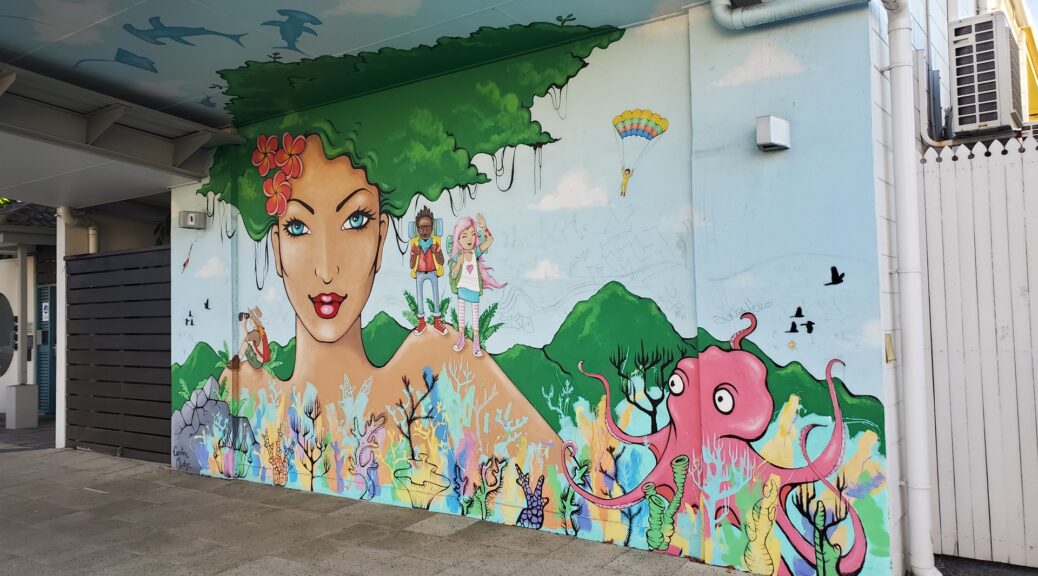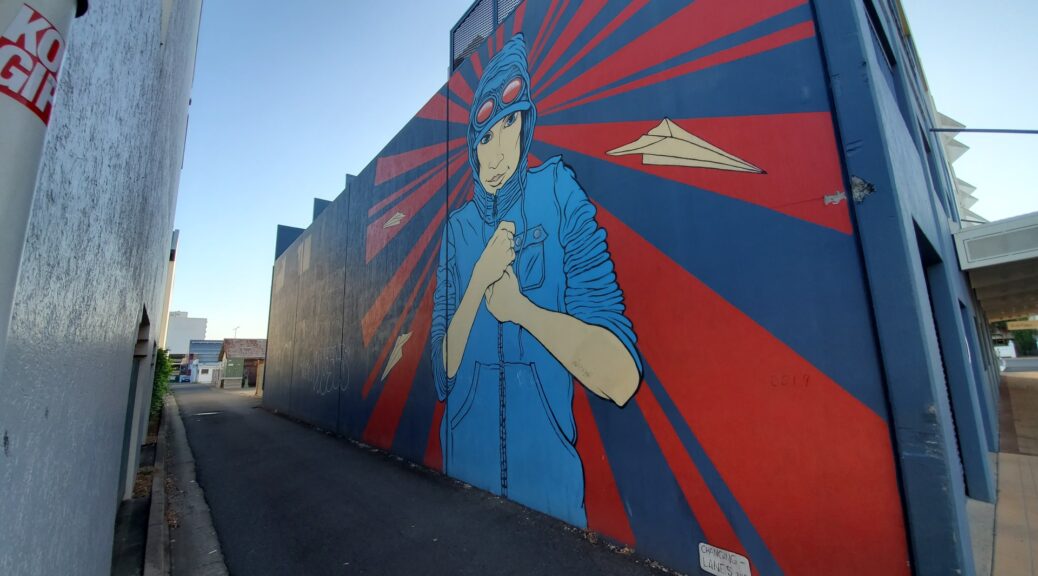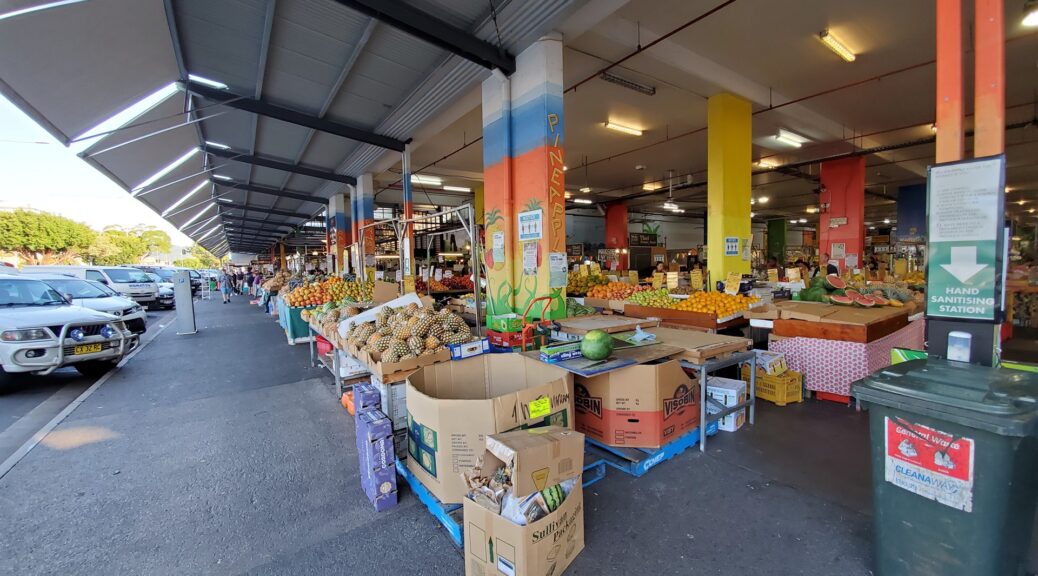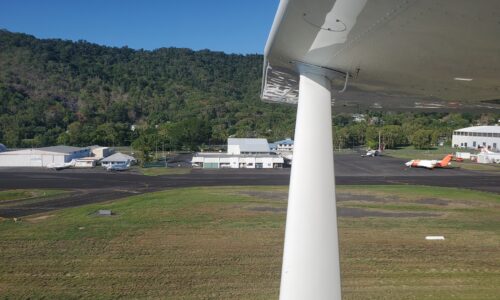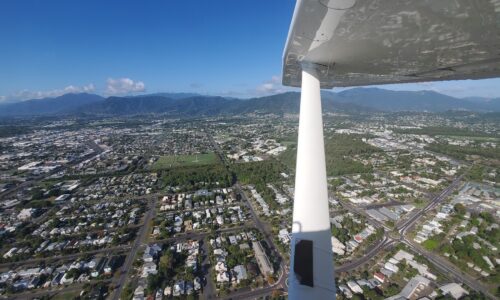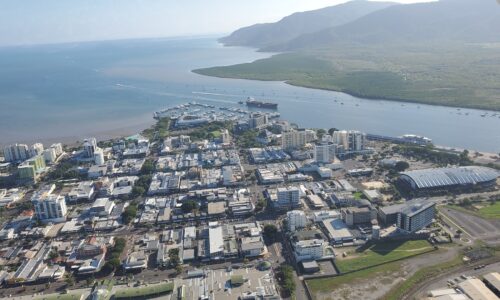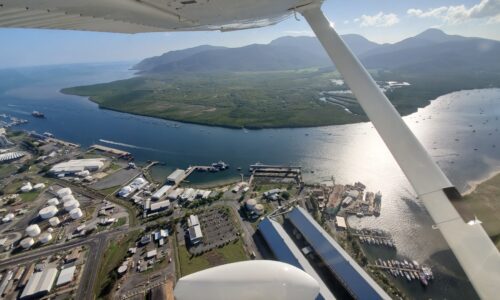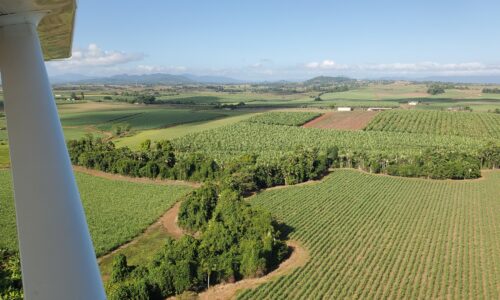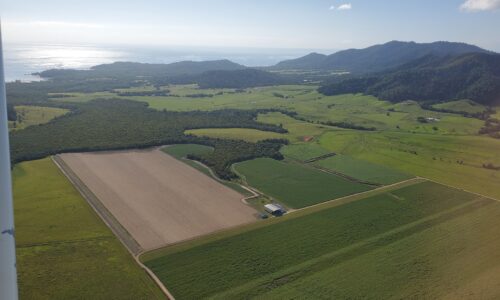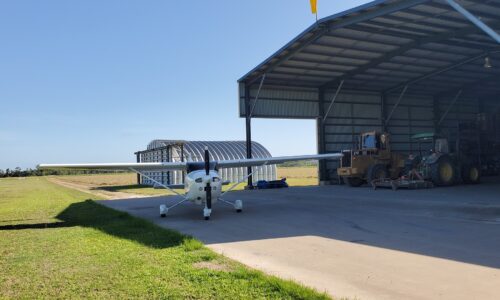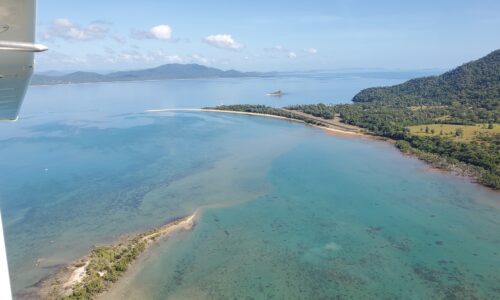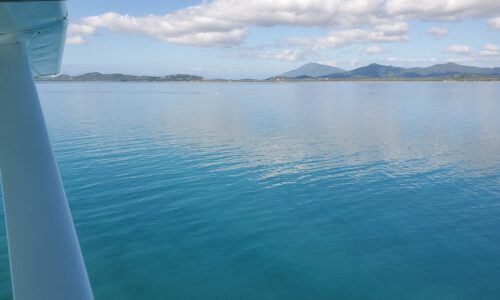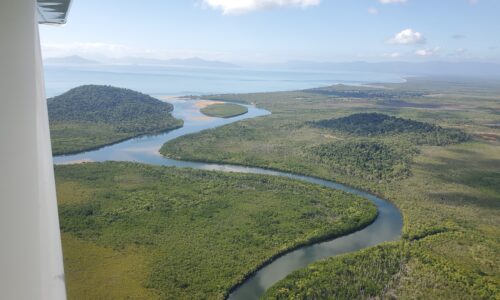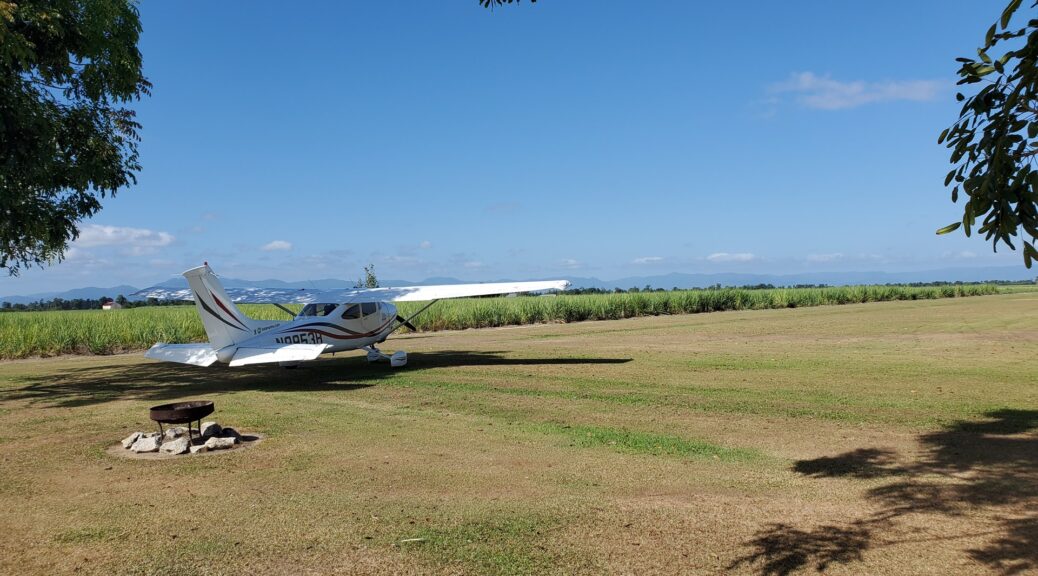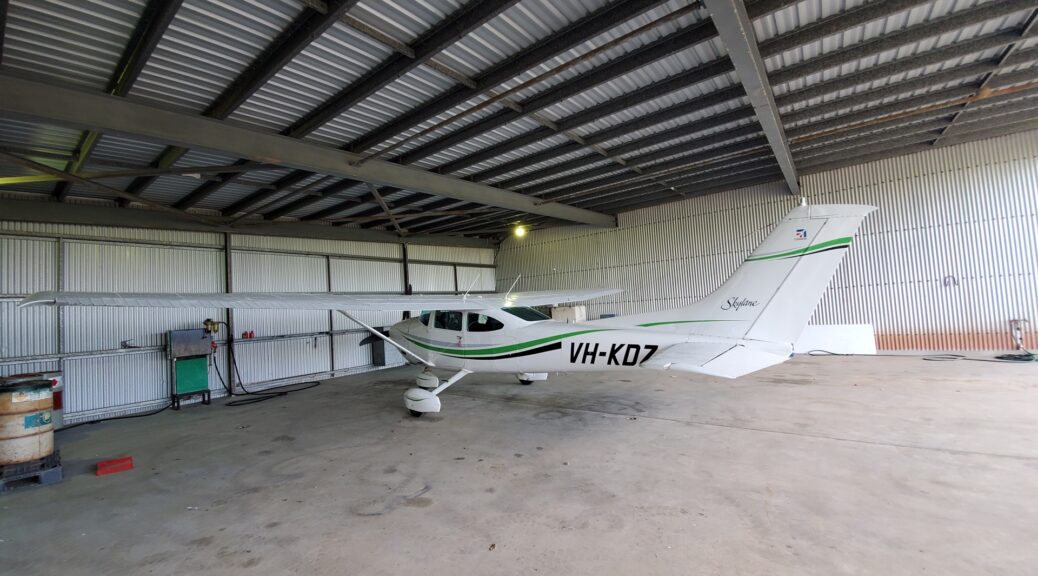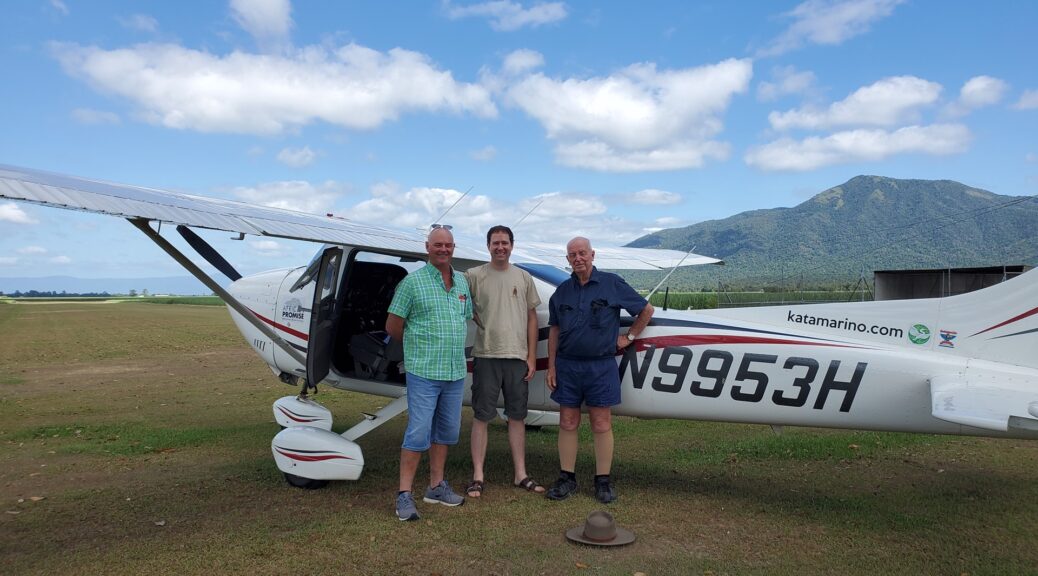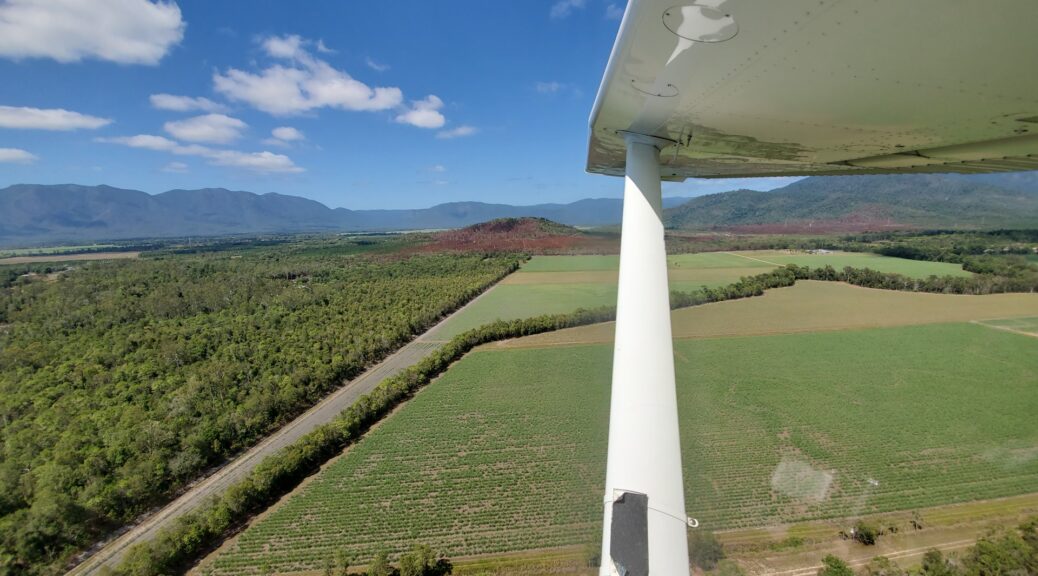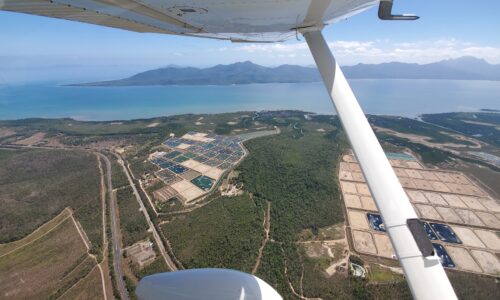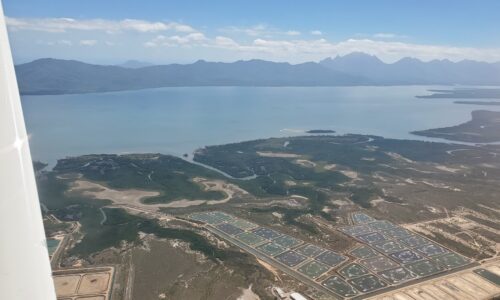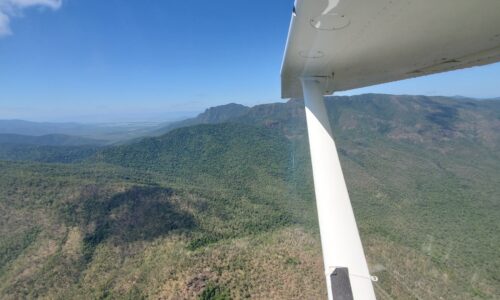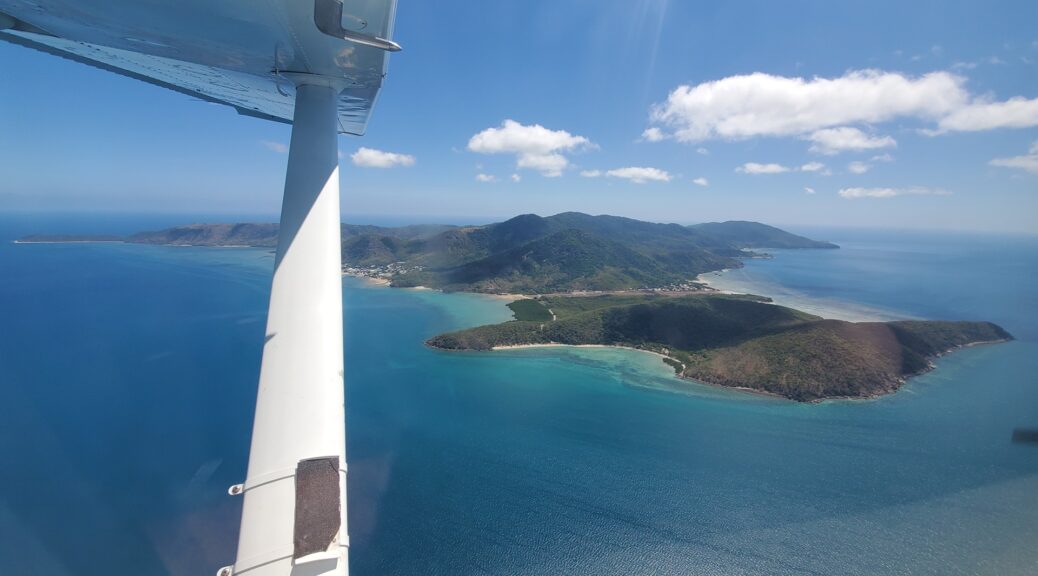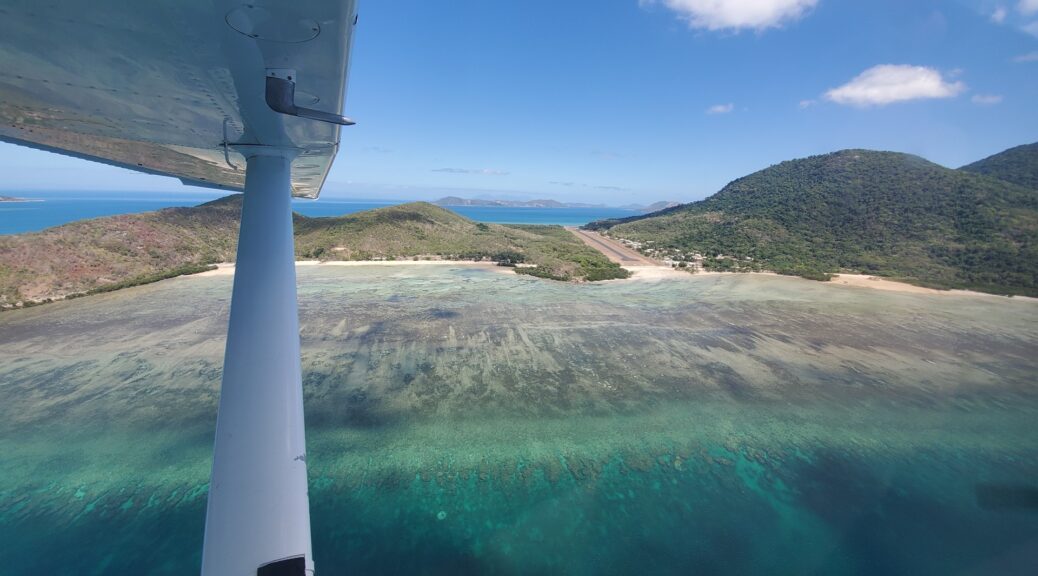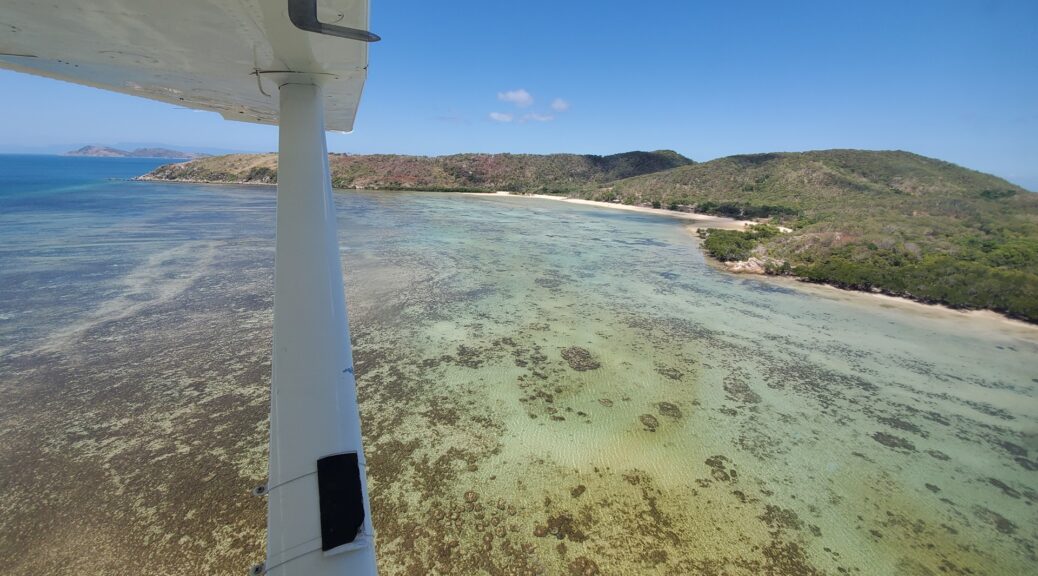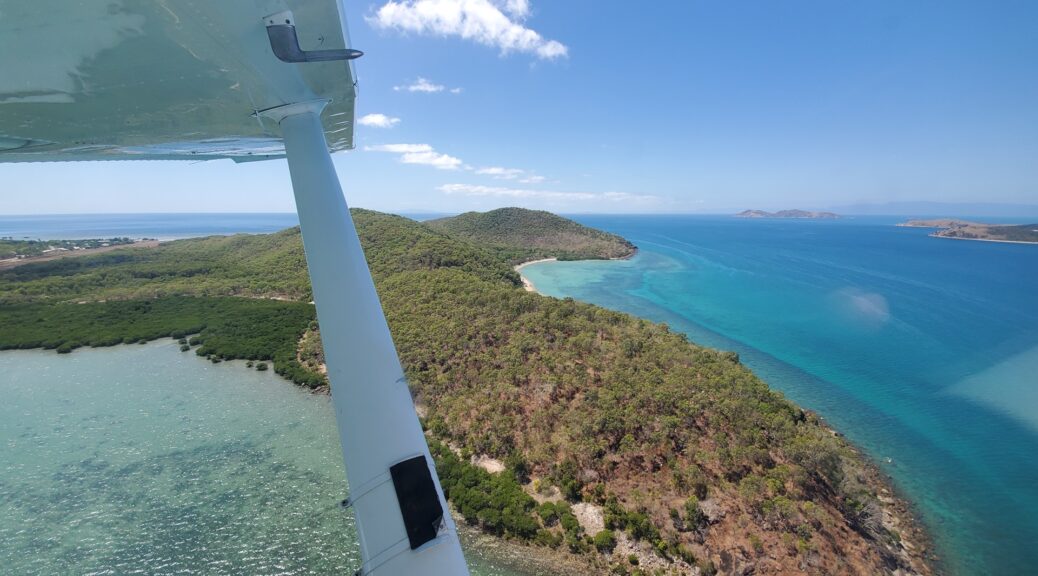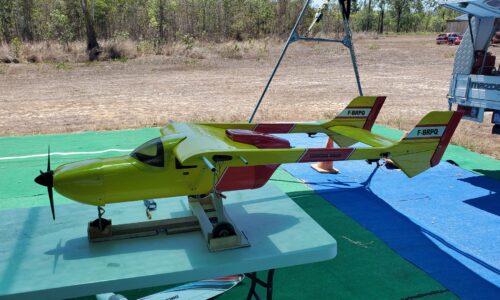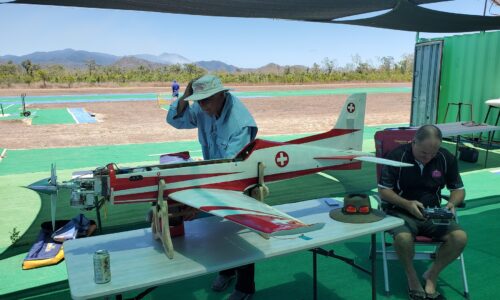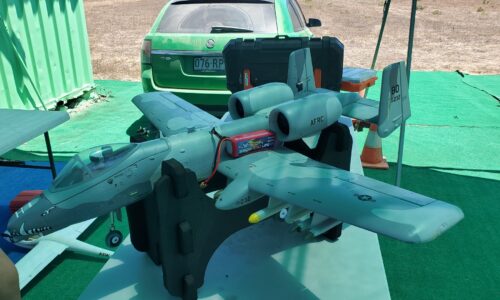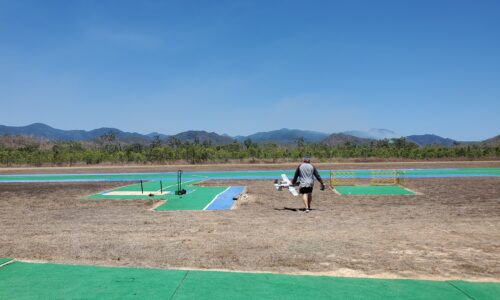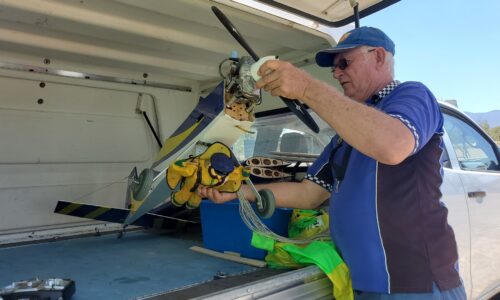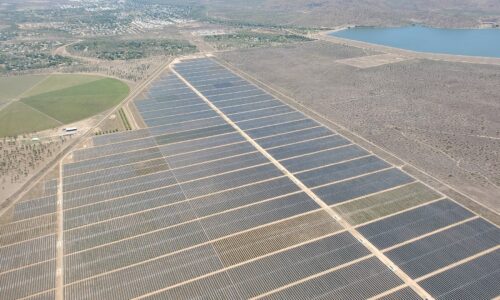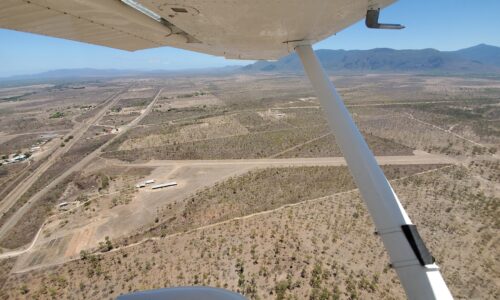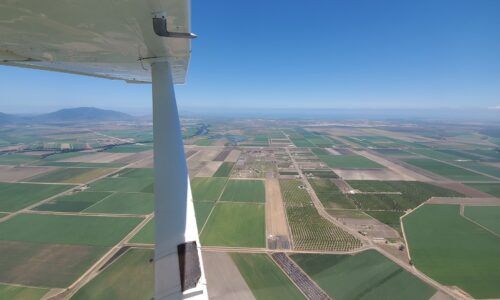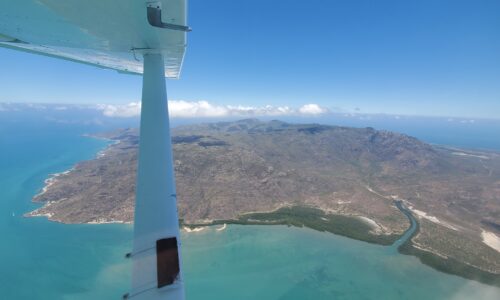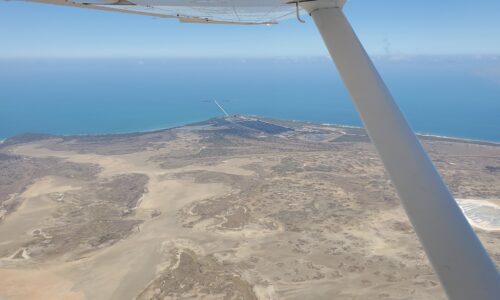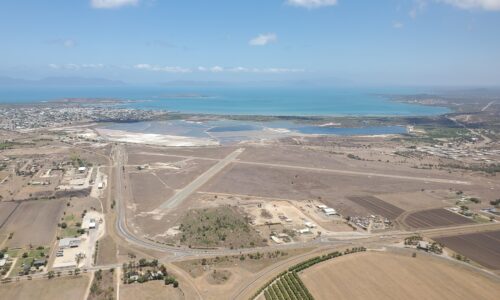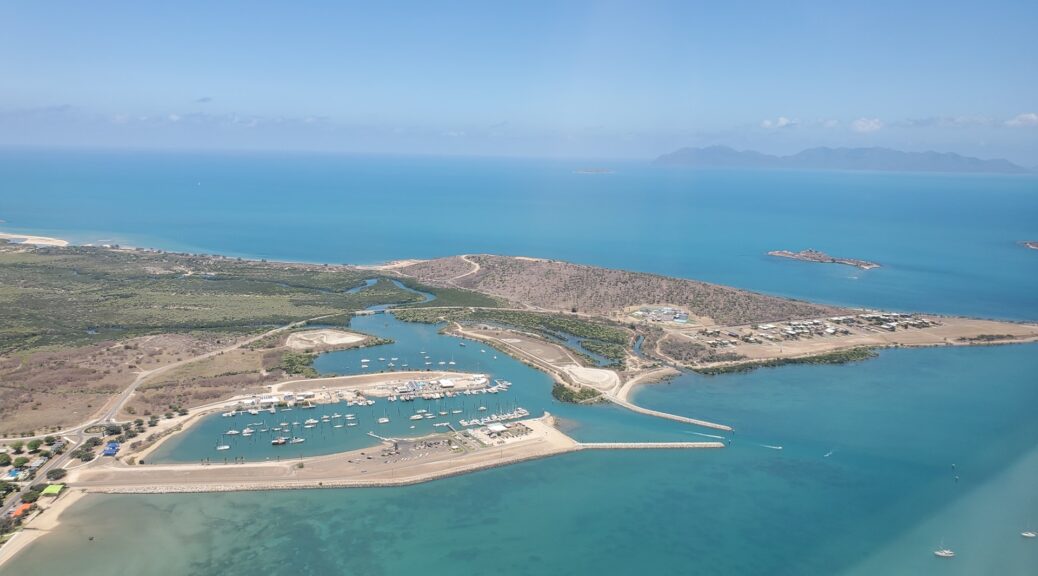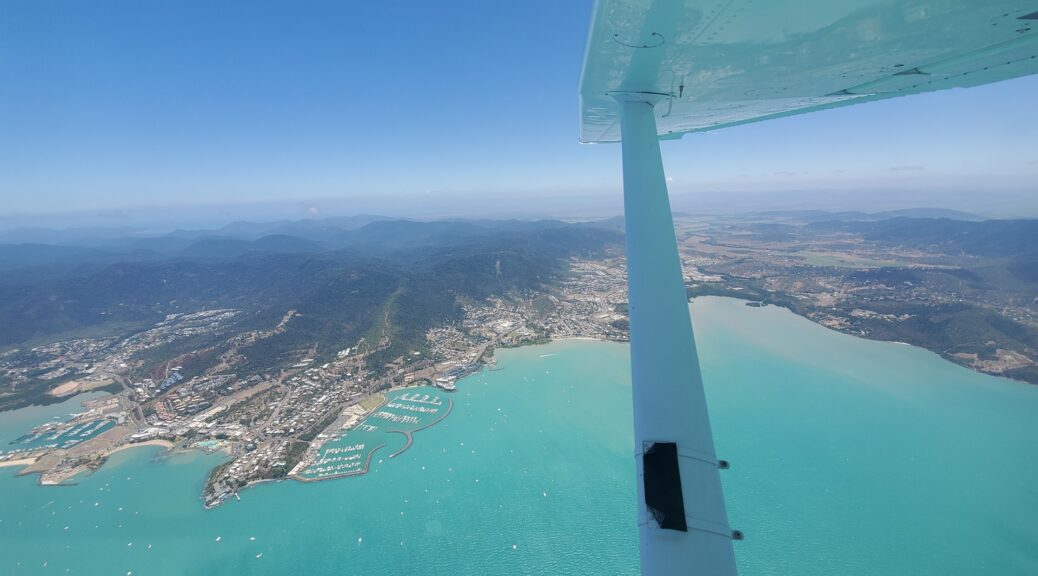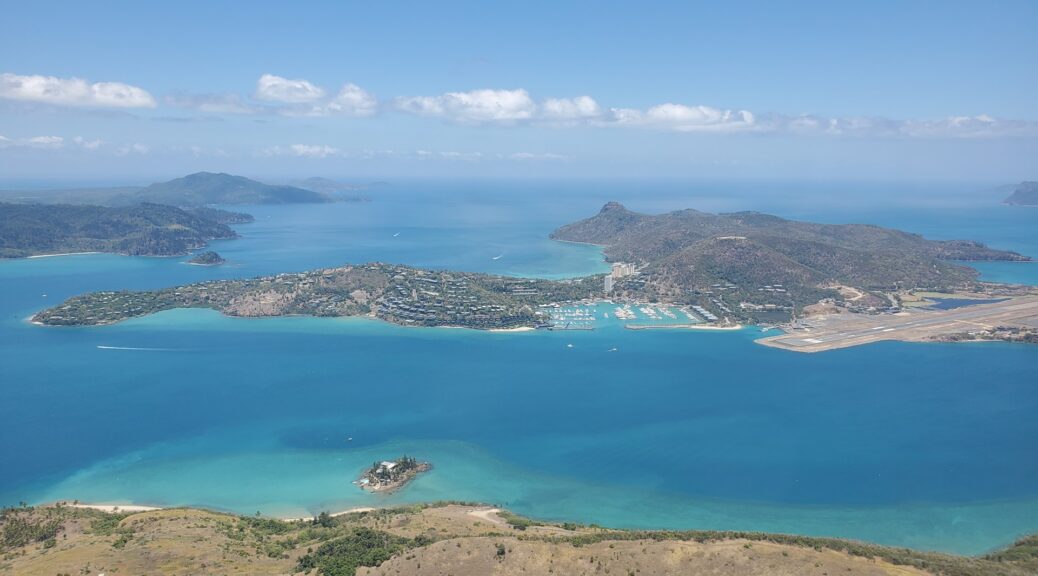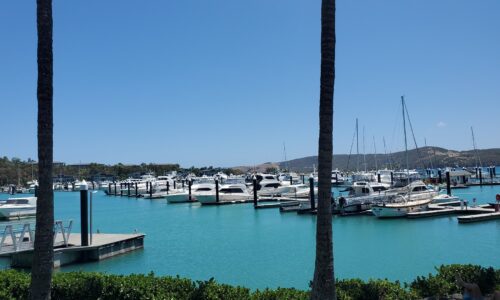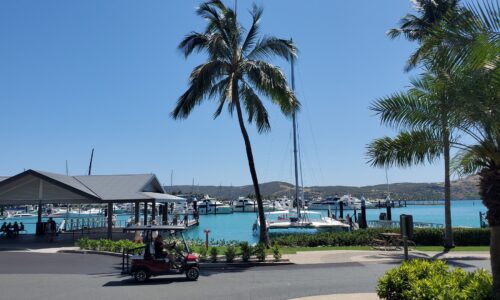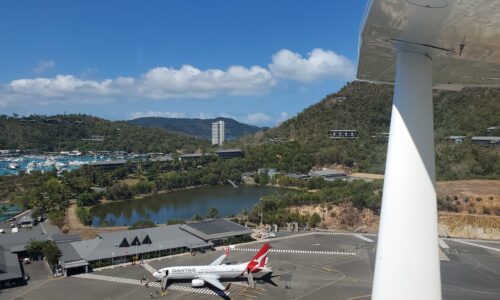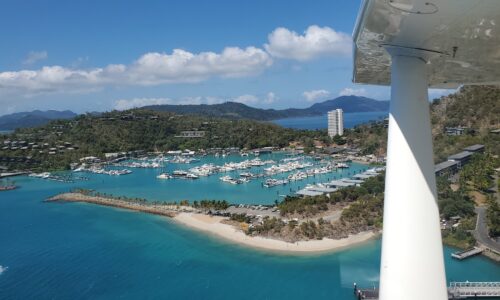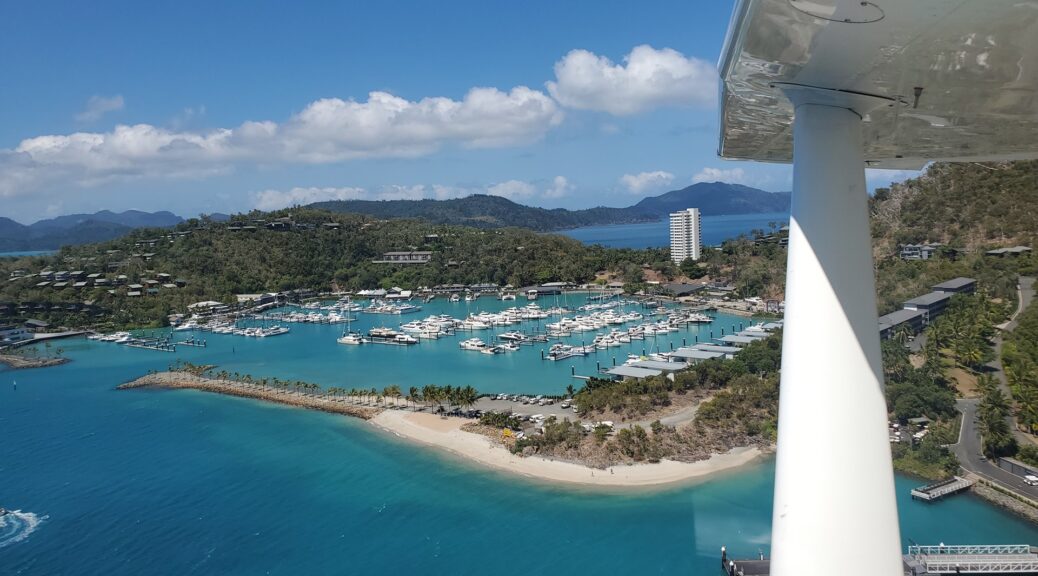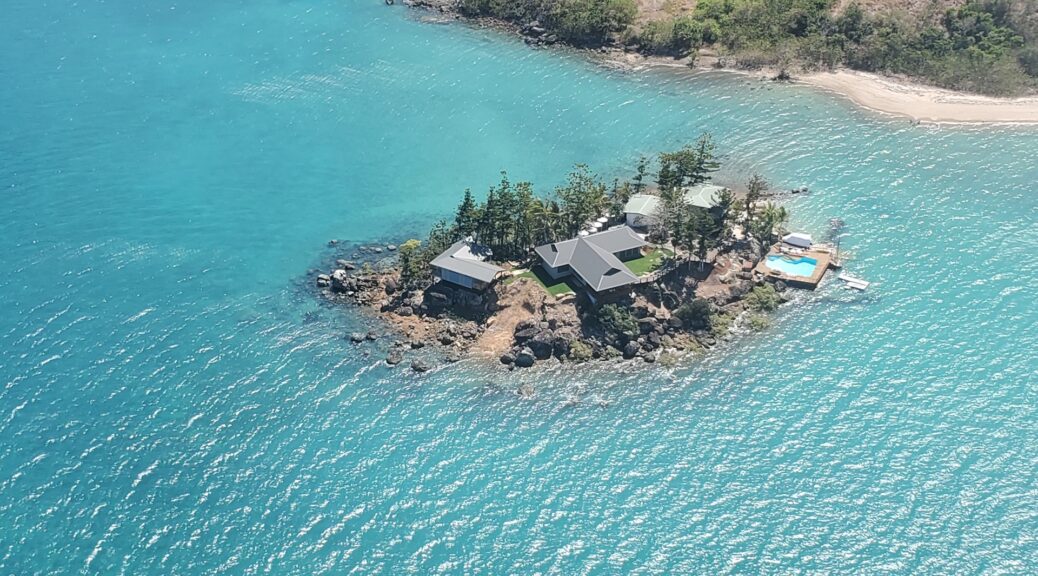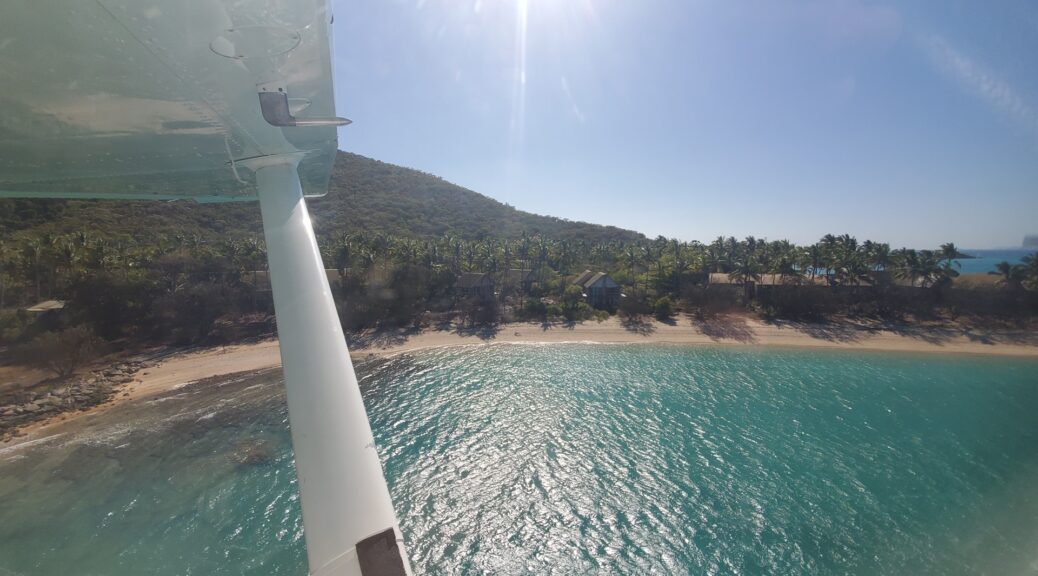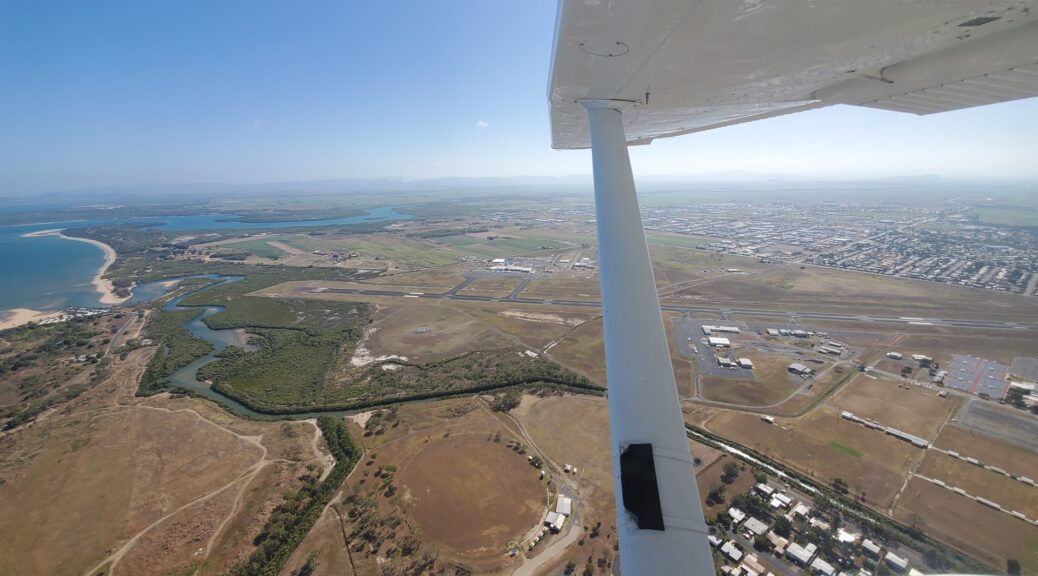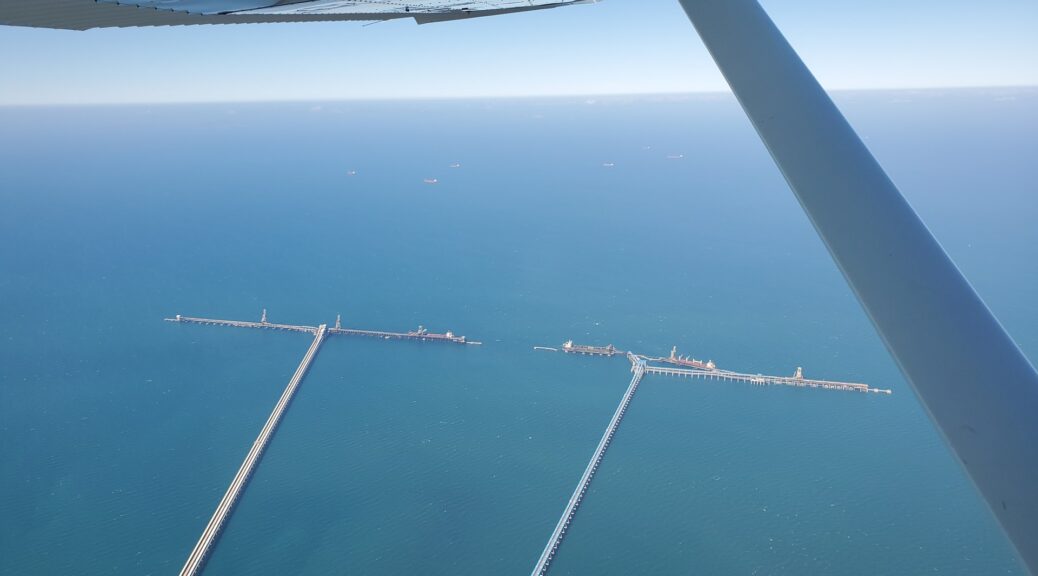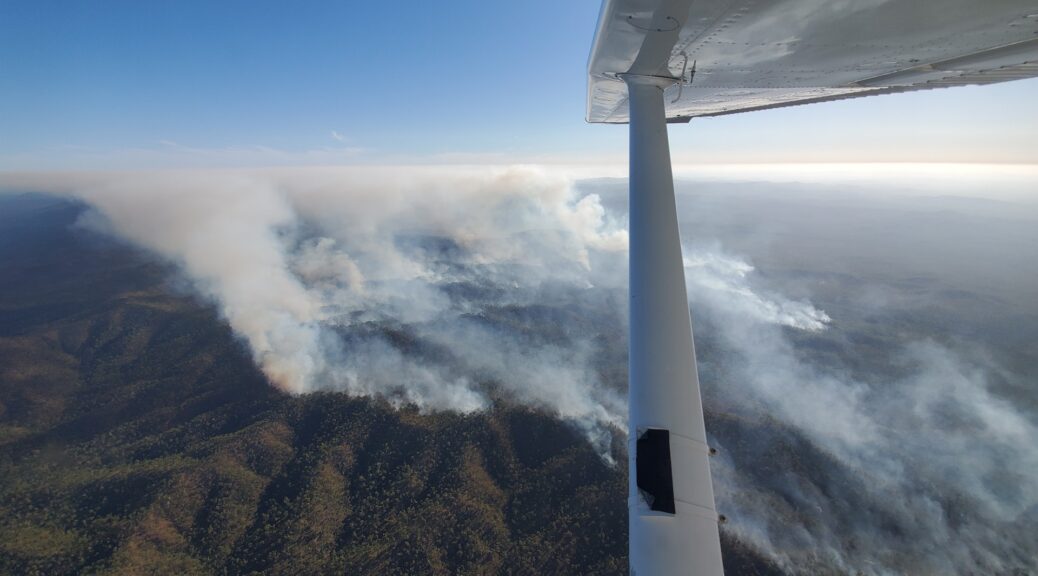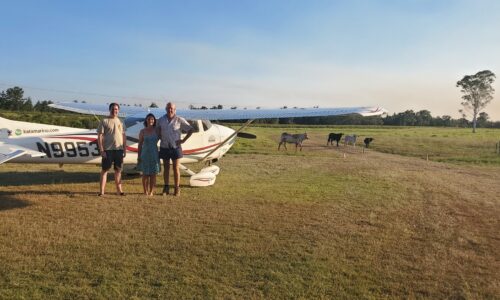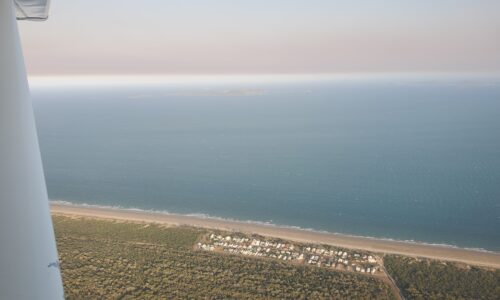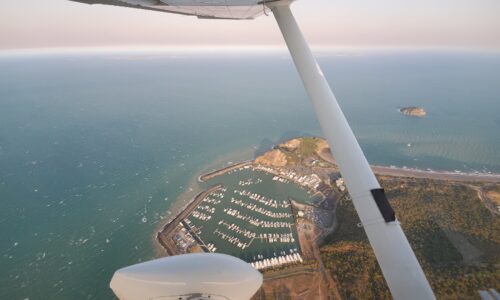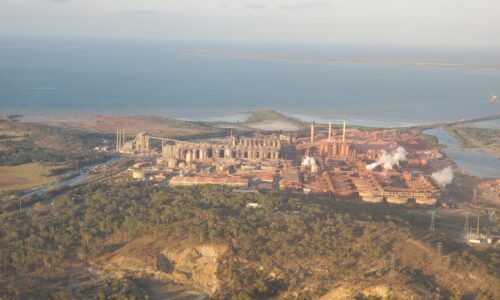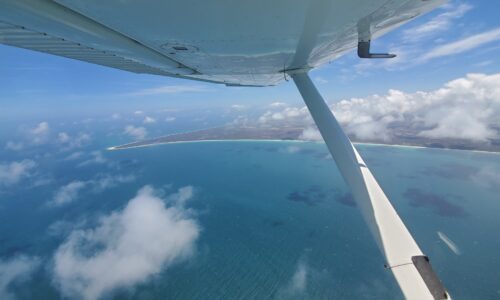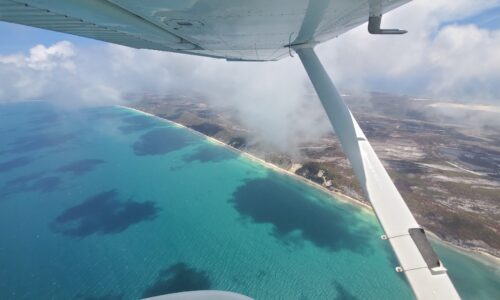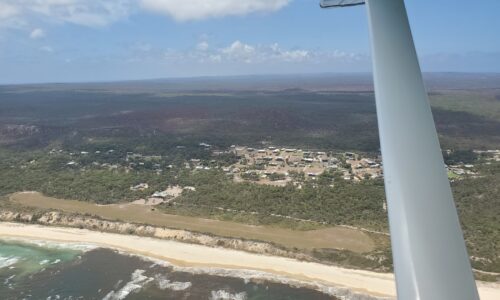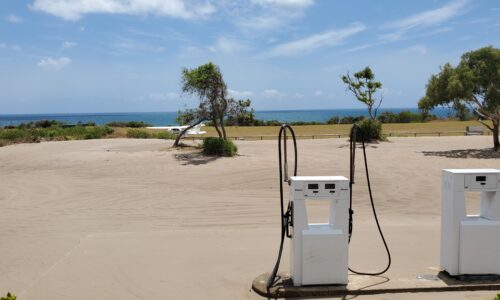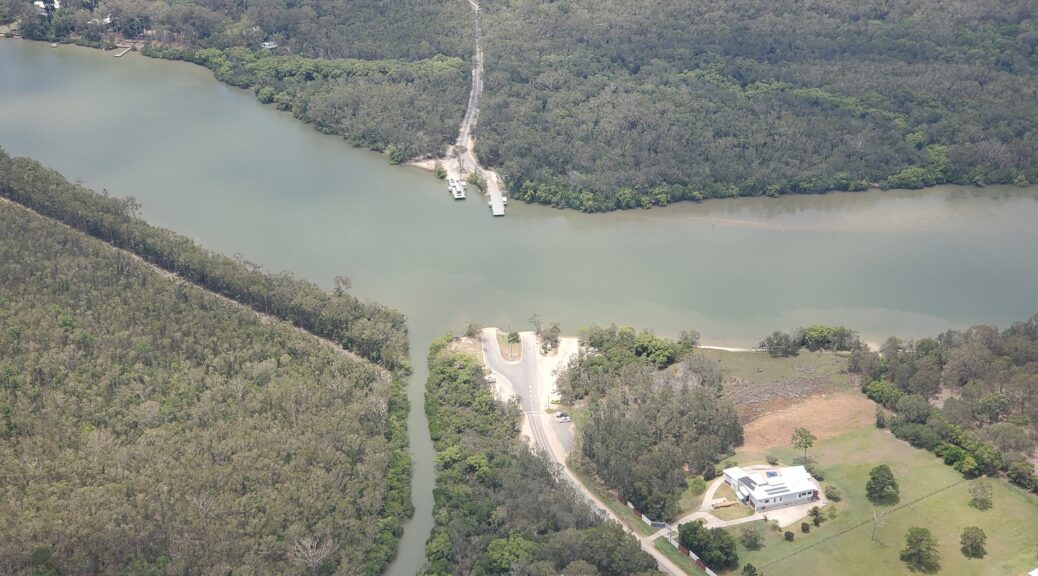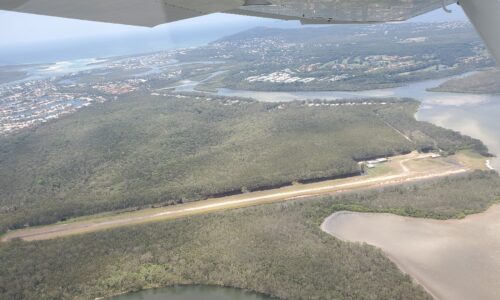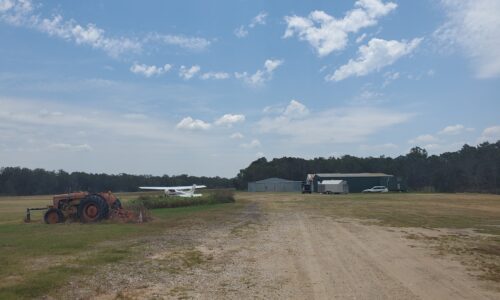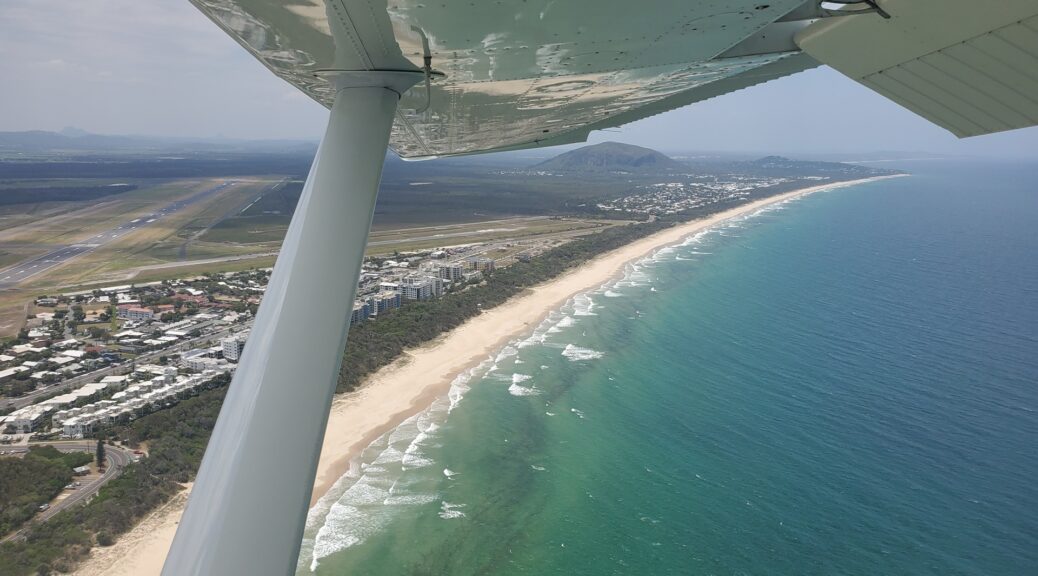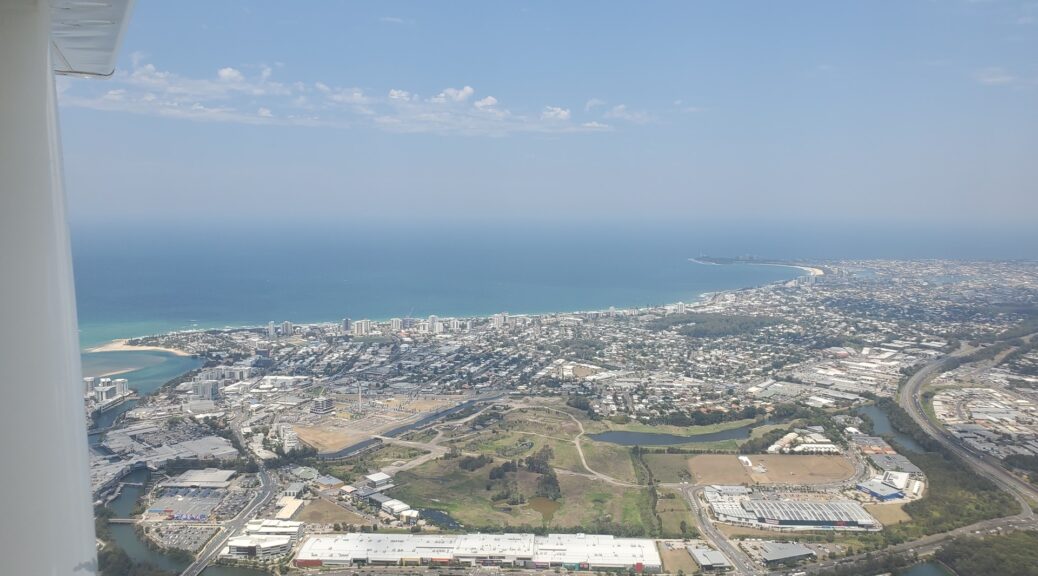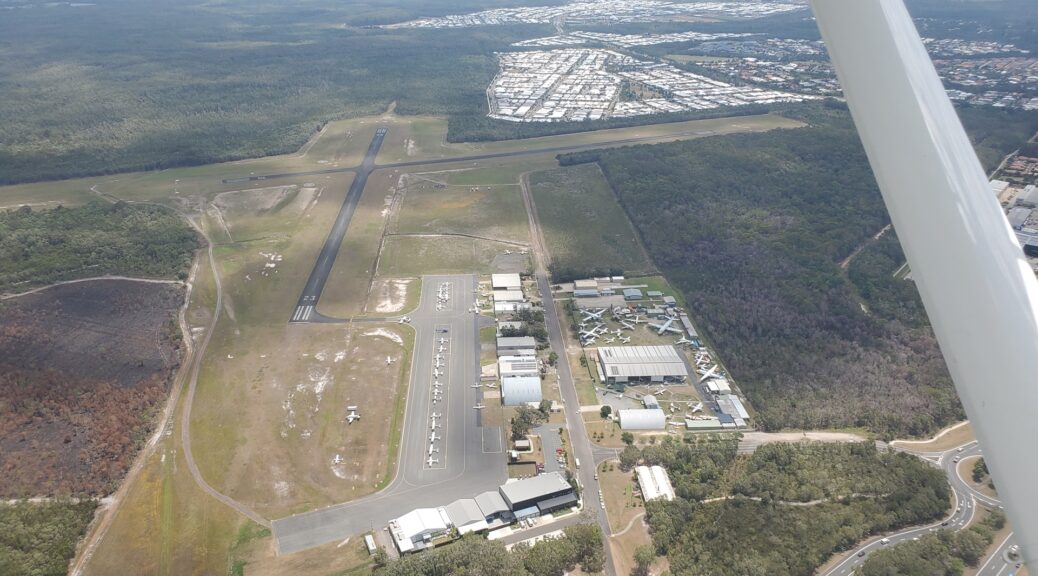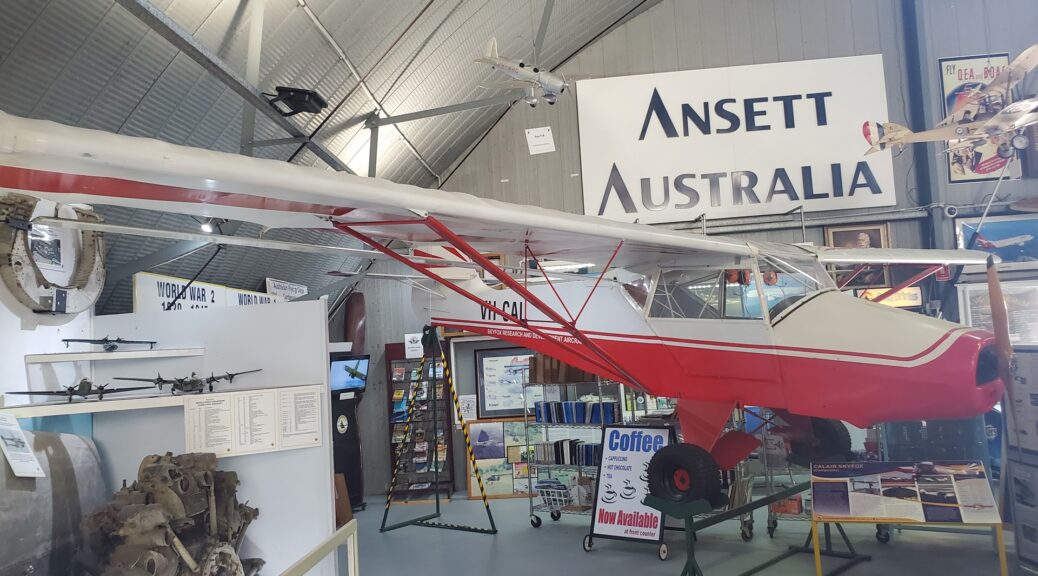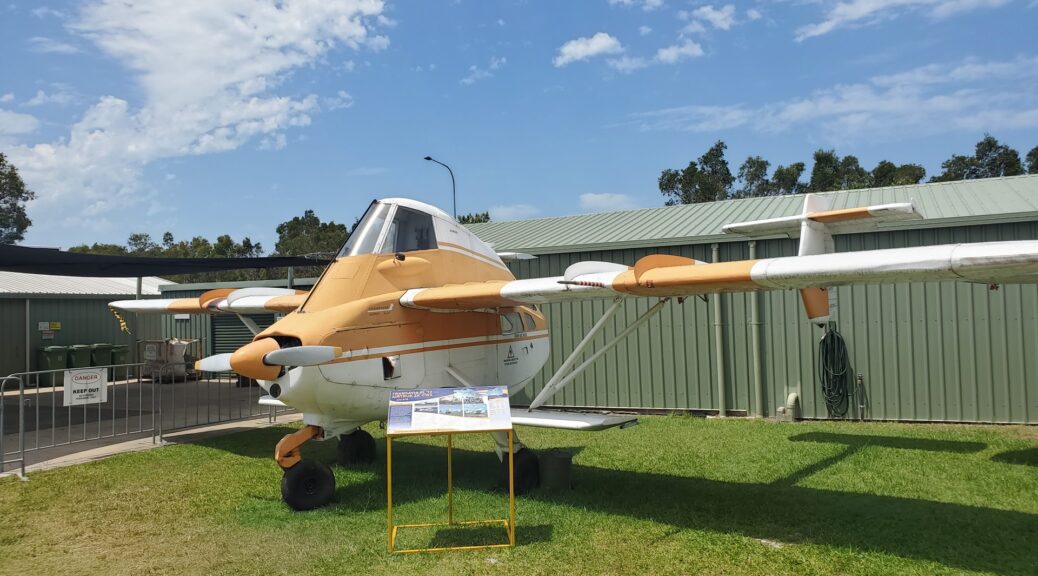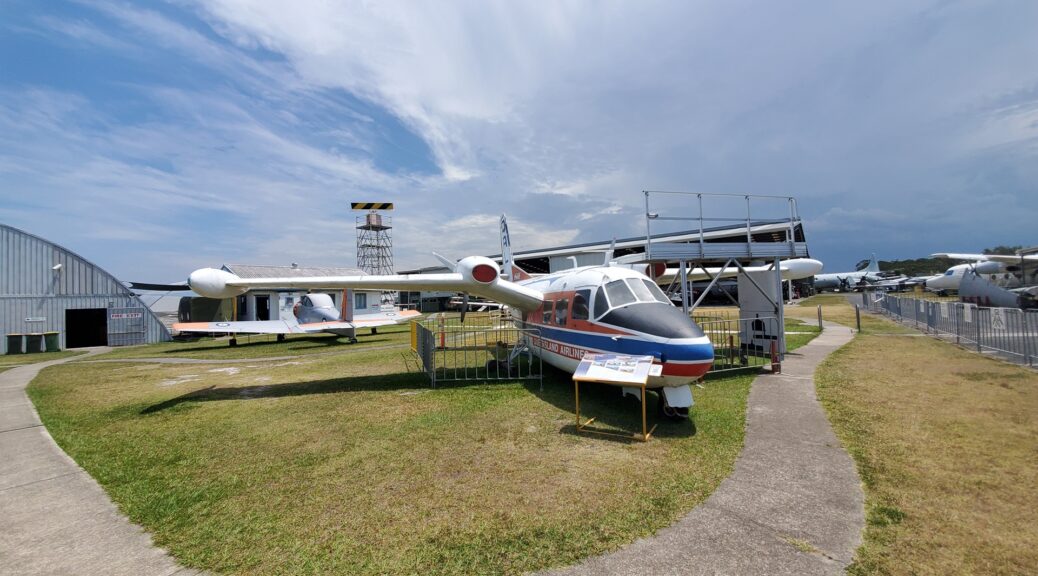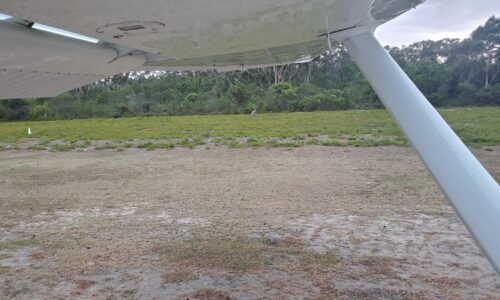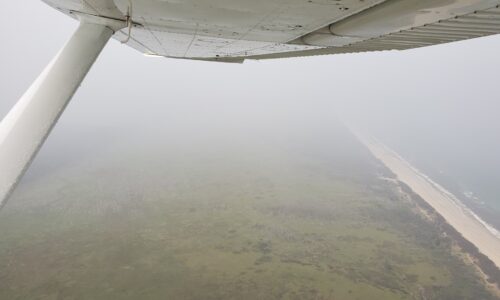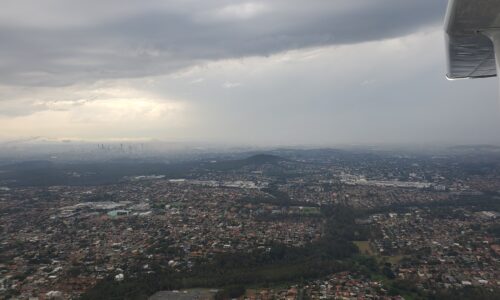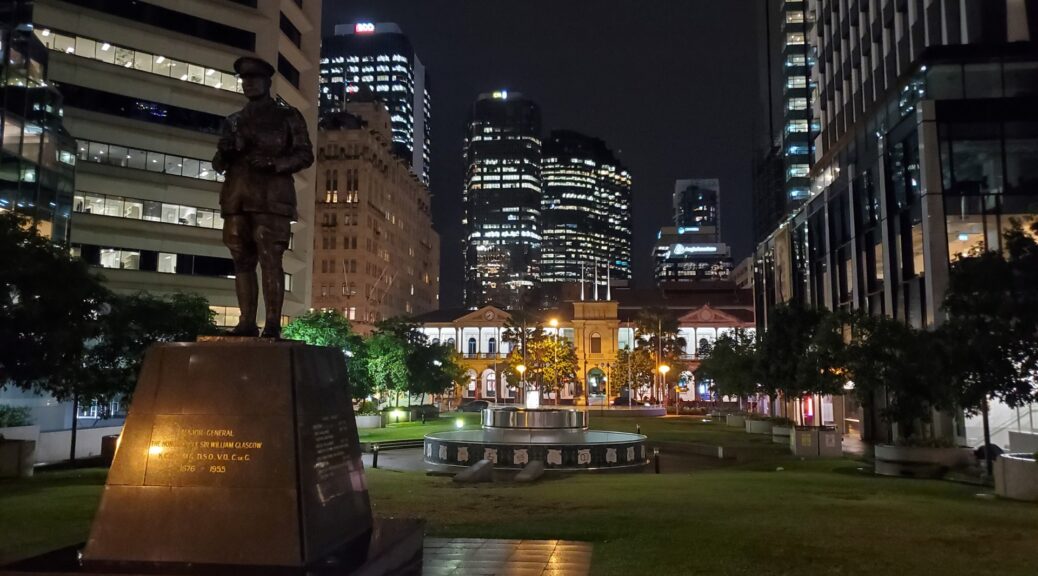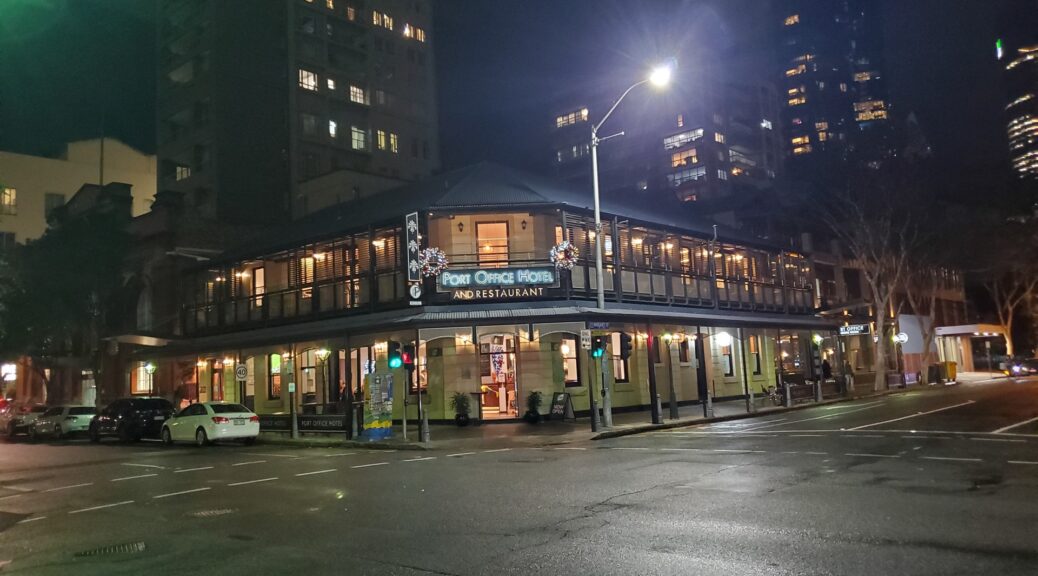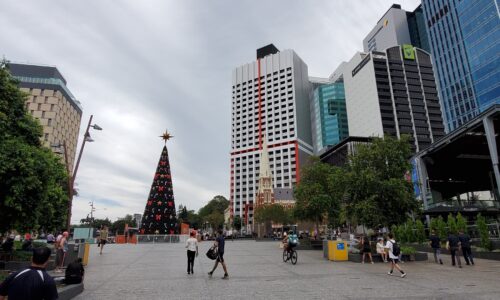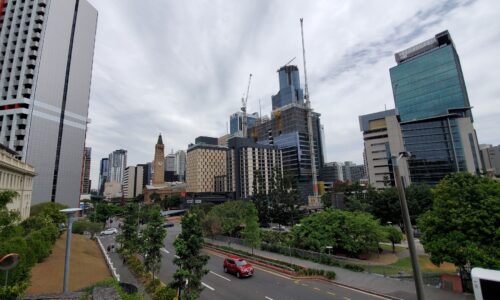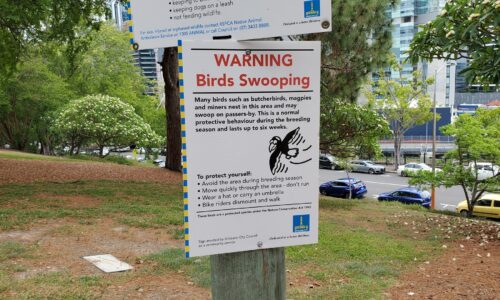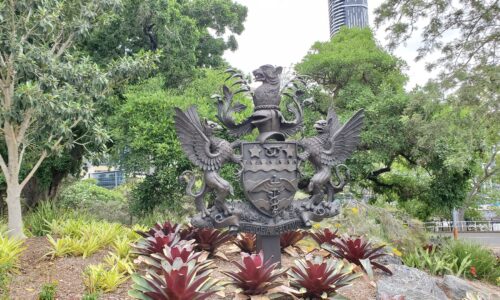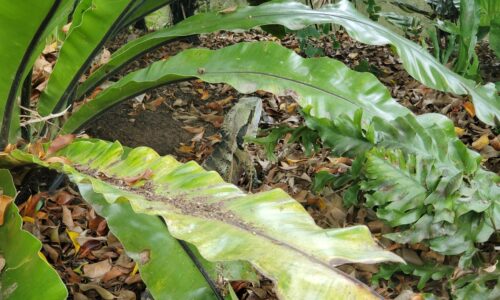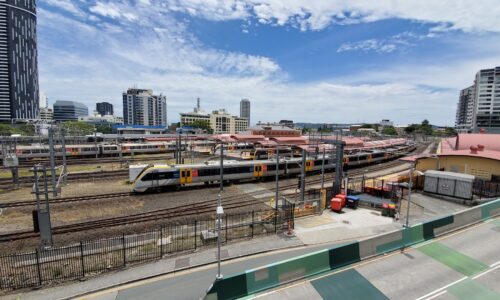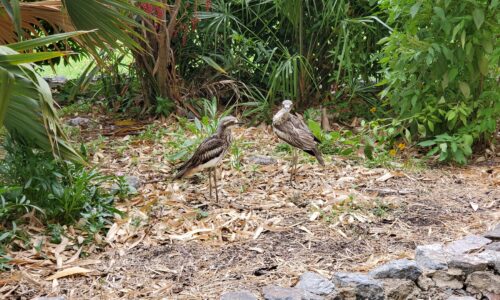Round the World – Australia 2, Part 10
I started my day bright and early with a visit to the nearby market for some breakfast. This bustling assortment of stalls was mostly full of various juicy and exotic fruits, but there was no shortage of pastries and drinks to choose from. Now well-fed, I called an Uber and rode back to Cairns’ GA terminal. The gate was locked, so I called the posted number and waited on the airport operations truck to arrive on the other side of the fence and let me in.
I’d refueled on arrival, so preparations for departure were quick; take off the cover, pack the aircraft, and perform the pre-flight checks. As I waited for the engine to warm up I chatted to Cairns Ground on the radio and received my clearance to depart their airspace to the south. There wasn’t much other traffic around. Ground directed me to a runway intersection for departure, correctly assuming that I would not need the full length of Cairns’ 10,354 ft runway. Tower cleared me for take off and I pushed in the throttle and rose into the smooth morning air.
The remote country of the Australian outback and the northern cape were behind me now, and I was back in relatively developed territory. This meant that the density of small airfields was much higher! My plan for the day was to make my way down the coast, landing at every strip which looked interesting. My first landing was at the airport of Innisfail, which advertises fuel availability in the Australian Flight Guide, but a phone call had revealed would only sell to local pilots. No matter, as I had plenty to keep me going! It was deserted and I didn’t hang around, but continued to the small grass farm strip at Bingil Bay.
Bingil Bay strip is a simple turf runway just inland from the town of Kurrimine Beach. Kurrimine is believed to have been an Aboriginal word meaning “dawn” or “sunrise”. The town has a population of a little over 700. I had a lot of ground to cover today however, so didn’t spend much time at the strip; I parked up next to the large barn half-way down the runway and had a brief rest before hopping back into the pilot’s seat and taking off. I flew south over the coast, leaving the land over Mission Bay and heading for Dunk Island.
Dunk Island lies only 4 kilometers off the coast of Mission Bay. Europeans first settled on the island in 1897, which is an interesting tale in itself:
In 1897, suffering from work anxiety and exhaustion, and advised by doctors that he had just six months to live, writer Edmund James Banfield moved to Dunk Island with his wife Bertha – so becoming the island’s first white settlers. Previously a journalist and senior editor with the Townsville Daily Bulletin for fifteen years, Banfield let the tranquillity of this unspoilt tropical paradise weave its magic and he lived on Dunk Island for the remaining 26 years of his life until his death in 1923. A small hut built with the assistance of an Aborigine called Tom was the Banfields’ first home. Over a period of time they cleared four acres of land for a plantation of fruit and vegetables. Combined with their chickens, cows and goats as well as the abundance of seafood and mangrove vegetation, they lived very self-sufficiently.
Wikipedia
A resort was founded on the island in the 1930s, before the Royal Australian Air Force took over the island during WWII and installed an airstrip and radar station. After the war the island returned to resort life; an artist’s colony also existed on the southern side of the island. The resort passed through a number of different owners through the years, before being devastated by Cyclones Larry and Yasi. Since the latter, in 2011, the resort has lain in ruin.
As I climbed out from Dunk Island, I heard another Cessna 182 on frequency calling his departure for a short scenic flight from the private strip at Lower Tully. I chatted with him, and he gave me permission to land there and a few tips about how to do so. The strip is simply a strip of grass carved out of a farm field at the pilot’s house; a setup like that is the dream for most pilots! I arrived before he returned, parked up near the house, and hung out with a friendly dog while waiting for him to land. The view from the patio out along the strip and towards the mountains was magnificent.
Before long another Cessna 182 touched down and taxied back, parking up in a hangar adjacent to the house. Out jumped the owner and his friend, who had been up for a scenic flight. We spent a while looking over each other’s aircraft and chatting about our respective flying before they bid me farewell and I took off, heading south along the very Australian-sounding “Bruce Highway” to continue my whirlwind tour of small Queensland airports.
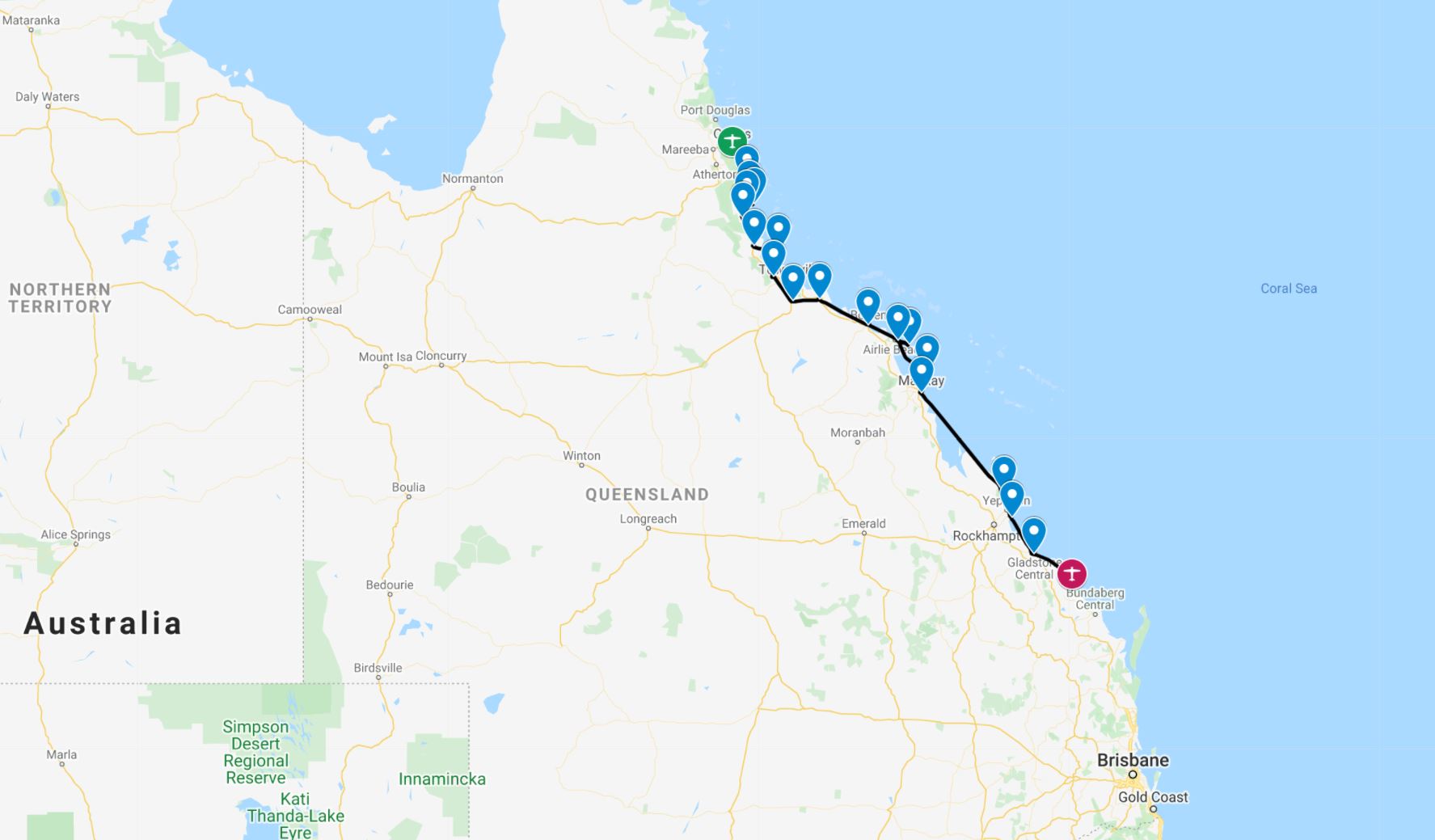
I performed brief landings at Cardwell and Ingham airstrips before it was time to turn a little to the east and head offshore again. This time I was aiming for Great Palm Island. Much larger than Dunk Island, Great Palm has a large paved public runway and about 2,300 residents. When first spotted by European settlers the island was estimated to have a population of around 200, with the majority of the growth coming during the 20th century when the island was used as a penal location for resettling members of the Aboriginal population who were considered “troublesome”. Difficult relations and apparent poor treatment by the government has, depressingly, continued into the 21st century. I knew none of this at the time of my visit, and with a lot of ground still to cover, didn’t stop for more than a few moments before continuing.
I passed back onto the mainland just west of Townsville, passing a fish-farming operation off to the east. My destination was Bluewater Park, and I had called ahead for permission; the man who answered the phone had let me know I was welcome to visit, but that radio-controlled aircraft would be using the strip. Indeed, when I first announced on the local radio frequency I was responded to by an aero-modeler who let me know that they were active and would be landing their aircraft prior to my arrival. I parked up close to the aero-modeler’s setup and wandered over to say hello.
5 or 6 keen modelers were hanging out on this sunny Saturday morning. They had a good setup with containers for storing items, and shade awnings to cover the working and resting area; an essential feature in Queensland! They were kind enough to take some time and show me their aircraft and their storage container, which was packed full of other models and supporting items. I made myself a Nutella sandwich from their little kitchen and watched some of the flying as I ate; given how twitchy and responsive the models were, it looked a lot more difficult than flying a full-size ‘plane!
The modelers gave me some good advice about which parts of the slightly decrepit runway I should stick to on take-off, before grounding their aircraft again for me to taxi out and depart. I climbed into the air once more and pointed south, around the imaginatively named town of Townsville (which equates to “Town-town”, good job to those who named it). I touched down briefly at the small and deserted Donnington Airpark before turning east and heading towards Hamilton Island. Along the way I made further stops at Ayr and Bowen; I didn’t realise it at the time, but in Bowen I missed the “Big Mango”, an attraction I clearly need to return to visit at some point in the future.
Hamilton Island is a privately owned resort island, and has its own commercial airport big enough to accept Boeing 737 and similar aircraft. It is marked in the flight guide as requiring PPR (prior permission for landing) which I had not phoned ahead for, so I called up on the radio to ask if it was possible to receive PPR over the radio. “No problem”, said the controller, “come on in!” I did so, touching down into a stiff headwind and following tower’s directions across the cramped ramp area to parking.
I shut down, and used both sets of chocks to secure Planey against the strong breeze. After a while a smartly dressed lady arrived clutching an iPad and took my landing fee payment, as well as admonishing me for not obtaining PPR; I did politely point out that permission had been requested and granted by radio, and no more was said. She gave me details of how to get down to the water front, and off she went. Following her directions, I called up the resort shuttle and a few minutes later I was dropped by the harbour. Time for lunch!
It was a busy and sunny day at the harbour on Hamilton Island. The resort offers all kinds of typical holiday activities including water sports, golf, a spa, sports and wildlife viewing to name just a few. I didn’t have time for any of these, but did have enough time to grab a toasted sandwich and an ice-cream which I enjoyed while gazing out over the harbour. All too soon it was time to take the shuttle back to the airport, accessing the ramp with the code I’d been given on arrival, and following tower’s directions back to the runway. Departure took me directly out over the harbour with fantastic views of the luxury yachts and high-end accommodation overlooking it, as I set course for Airlie Beach.
We had stopped in Airlie Beach for a couple of nights in December of the previous year. The reason I was dropping in again was that I now was online friends with a pilot who lived on the field. He’d invited me to drop in for a cup of tea and I was happy to do so, and sit for a while chatting about my flight and his life in aviation as a helicopter pilot servicing oil rigs. He also had a small amphibious aircraft, which looked like the perfect toy for flying around the Whitsunday islands!
We said our goodbyes and he waved me off as I took off from Airlie Beach and continued southeast along the Queensland coast. I wanted to stop next at Brampton Island, so my track took me a little offshore towards this destination. It was first settled by Europeans in 1916, and the first resort was established in December of 1933. The resort operated sporadically until early 2011 until it closed for refurbishment after a typhoon; it has never re-opened. The luxury cabins are clearly visible on climb-out from the runway, in a state of obvious disrepair.
Brampton Island did not invite hanging about, and I didn’t even come to a stop before pushing in the throttle again and taking off. I returned to the mainland just north of the town of Mackay, making a brief stop at the regional airport there before continuing south on a relatively long leg over more of the coastal waters and scrubland that make up this part of the state. Bush fires were visible here and there. My destination was Waterpark Farm, a plantation cultivating tea tree and eucalyptus, run by Jordan, Elodie, and their dog Bear. As I landed and taxied in along the very narrow grass taxiway they were there to greet me and shoo the cows out of the way as I parked.
Jordan and Elodie invited me to join them for fruit and soft drinks in their little pagoda, and told me a little about the farm. As well as producing tea tree and eucalyptus products they accepted visitors for eco-tours, and even had a little cabin on the farm for guests to book and stay. Unfortunately I had been too late to secure this for the night! After thanking them for the refreshments, the cows were shooed out of the way once again and I taxied out for departure.
The afternoon was drawing on, and the sun steadily dropping in the sky to the west. I set off on the final section of the day’s flying, continuing down the Queensland coast towards my night stop. Along the way I dropped into another couple of airstrips; first up was Emu Park. This dirt strip is well maintained, but I had been warned by the manager that there was a good chance that kangaroos would be hanging around!
No kangaroos interfered with my brief visit, and I continued south with a brief stop at the regional airport in Gladstone. My destination soon came into view in the evening light, just before sunset. This was good, as the dirt airfield at Agnes Water is unlit. This was another location where I had been warned about kangaroo incursions and indeed, I saw a few at a safe distance as I touched down and taxied to parking. Securing the aircraft, I walked across the road to my hotel in the town of Seventeen Seventy. This rather unusual name was adopted by the town, originally known as Round Hill, in the 1930s to recognise its historical significance as Captain James Cook’s first landing point in Queensland.
I made it to the hotel shortly before the front desk closed. When entering my room I was surprised to discover that it was already occupied, and backtracked quickly to the front desk to request alternative accommodation. This was granted, and the second time around things went much better!
As usual, it was an early start the next day. My plan was to make it as far as Brisbane for a couple of night’s relaxation. First stop for the day would be Orchid Beach, on Fraser Island. This is a sand/grass strip on the seaward coast of Fraser Island, serving a small holiday community. Fraser Island was suffering from significant wildfires at the time, started by a campfire which had grown out of control; over the next two months it burned more than half of the world-heritage island. There were many restrictions in place regarding travel and flight, so I called the airport operator before departure to ensure that it was OK to visit. Getting the go-ahead, I departed from Agnes Water and set out over the sea.
Spanning 180,000 hectares (440,000 acres), Fraser Island is known for its tropical rainforests, sand dunes, and inland lakes. It is home to wild dingoes and several rare plant species. It is also the world’s largest sand island with over 250 kilometers (160 miles) of sandy beaches. About 100 people live on the island full-time, although hundreds of thousands of tourists visit the beaches each year. Of course, right now tourism was at a standstill.
No active fires were visible when crossing over the northern part of the island, and descending along the eastern coast towards Orchid Beach. I checked out the airstrip from above and all looked smooth and unobstructed, so I came in for a soft-field landing and parked up opposite the general store. Thankfully, the airstrip was rather firmer than the parking area for cars outside the store; even on foot, I was sinking into the sand and had a hard time walking across to the shop.
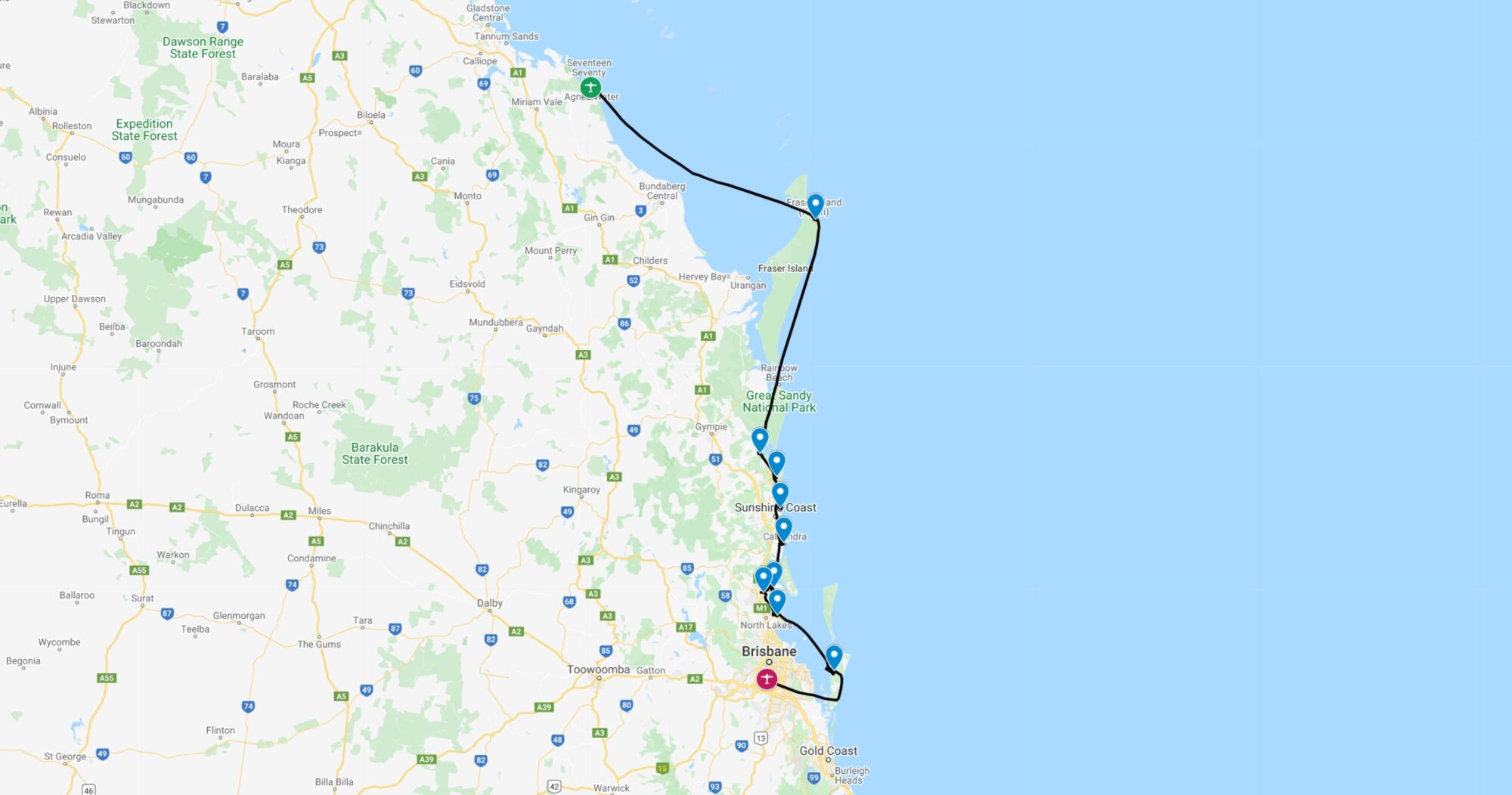
Because of the fires, the store’s opening hours were greatly curtailed, and I was just in time to pick up a drink and an ice-cream cone before they closed for the day. I sat outside at a picnic table and snacked; not a single other person was around. With little to do, and far to go, I started Planey up and taxied back to the departure end of the runway; I paid particular attention to the surface, trying to avoid any soft-looking spots. I made it safely and performed a soft-field takeoff, turning out to the right and departing downwind along the coast of Fraser Island.
I hugged the coast of Fraser Island, staying just offshore in order to be well clear of the restricted flight areas which were protecting the fire-fighting operations. I rejoined the mainland over Rainbow Beach and resumed my tour of small airfields, the first of these being a private strip at Boreen Point. The strip is owned by a keen pilot and aviation businessman who was there to welcome me and enjoy a brief chat on my arrival, before I continued south towards Brisbane.
From Boreen point I continued to Noosa, a club-maintained strip on the north shore of the shallow and salty Lake Weyba. Although the area had been identified as early as in Captain Cook’s visit in 1770, European settlement did not begin until 100 years later, primarily due to the difficulty of transport in the region. The Noosa region contains beaches and a beach national park, the cleanest river in South-East Queensland and an extensive trail network inland, linking a number of lifestyle villages, including Cooroy and Pomona. The airfield was quiet, with only one man to be seen; he was laying underneath a large box trailer, apparently trying to fix something.
Working my way south, I performed a touch and go at Sunshine Coast airport just for the fun of it, and then landed at Caloundra. This town marks the southern end of the Sunshine Coast region. The airport is home to the Queensland Air Museum, which advertises itself as the largest and most diverse aviation museum in Australia. The collection has a focus on Australian aviation heritage, with the centerpiece being an F-111; these imposing swing-wing strike aircraft, capable of Mach 2.5, were operated by the Royal Australian Airforce until as recently as 2010.
I spent an hour or so exploring the museum, which is split between two large hangars and an outside display section. The F-111 is shoehorned into the first of these hangars, making it rather difficult to get a proper photograph of it. The walls around are lined with display cases full of a wide variety of model aircraft, both civil and military. The aircraft collection is wide-ranging and at times eclectic, including a number of unusual and rare models such as the bizarre Transavia Airtruk.
One particular treat was to see a Beech Starship. This aircraft was developed in the 1980s, with no previous civilian aircraft ever having used carbon fiber composite so extensively before. It has turboprop engines in a pusher configuration with the propeller on the rear side of the wing, and a canard wing setup with the small wing at the front, and the large at the back. It’s a very futuristic-looking aircraft, and it was a shame that only 11 were ever built.
Stormy weather was starting to build up to the north and looked like it might start heading in my direction, so I finished off my visit to the museum and walked back across the car park to Planey. I paused on the ramp to allow another small aircraft to taxi in from a training flight, before back-tracking and taking off into the wind. I carried out a quick landing at the small Hazelton airstrip before hopping over to the larger regional field at Caboolture to refuel. As I pulled up at the fuel pumps the wind was starting to pick up a little, and towering black clouds were building just north of the field. A car pulled up next to me; inside was a man with a fantastic mustache by the name of Brad.
He suggested that I might like to stay at Caboolture while the weather passed, and I heartily agreed with him. I taxied Planey around to the front of his hangar as the storm broke over us and we tried to figure out a way to fit him into the hangar; however, given the existing occupants it soon became clear that this was not going to work. We pulled him as close as we could, to try and offer some shelter, and chocked him securely as the wind and rain set in harder. We stood in the hangar watching the storm wash over the field, and occasionally turning Planey around to face into the wind as the direction changed.
Eventually the storm passed, with Brad and I both soaked to the skin by our frequent forays out into the torrential rain to look after Planey. This was Australia in the summer though, and the drying process began almost immediately. Brad drove me out to the runway to inspect the conditions of that and the taxiways, and to check that I could taxi out for departure without getting stuck. With the route confirmed, I made my way out to the threshold and departed to the southeast.
I followed the shore of Moreton Bay to perform a touch and go at Redcliffe, and then struck out over the water towards North Stradbroke Island. This used to be simply Stradbroke Island, until being cut in half in 1896 by the Jumpinpin channel. A channel in the general area of Jumpinpin may have formed and silted up several times over recent millennia, however, the most recent formation of the channel is generally blamed on two events. The first of these was the wreck of the Cambus Wallace, a 75 m steel barque. In the early morning of 3 September 1894, the Cambus Wallace ran aground in heavy seas near what was then a narrow stretch of Stradbroke Island called Tuleen. The ship broke up where she struck and most of the cargo was washed ashore and plundered by local residents. During the subsequent cleanup, explosives from the cargo were piled up and deliberately detonated on the beach leaving large craters. The explosion is credited with severely damaging the beach and weakening the loosely vegetated sand dunes. Following gradual erosion of the seaward side of the island over the next two years, the second event to ultimately generate the channel at Jumpinpin was the arrival of a cyclone in 1896.
It was pretty misty and cloudy, but I didn’t have any trouble staying comfortably “VMC” (in visual conditions). I coasted in over the small coastal town of Dunwich and entered the traffic pattern of Dunwich Airfield, also known as “Straddie”. This is a recreational grass field and turned out to be home to a mob of about 20 eastern grey kangaroos led by a large ‘roo apparently known as Bob. A friendly caretaker (human, not kangaroo) lives on the airstrip in a caravan and came out to greet me and offer tea and biscuits. He was also keen to demonstrate the rapport he had built up with the local magpies, who all flocked over to see him as soon as he approached the picnic table he feeds them on.
After tea, it was time for the final flight of the day. The caretaker and I had been watching the radar, and it looked like more rain was on the way. Conditions were still not great so I wanted to make the most of the remaining daylight to find my way to my stop for the next couple of nights, Brisbane’s Archerfield. After back-tracking along the runway to try and shift any kangaroos I took off to the northwest, back over the town of Dunwich. I had barely made it offshore however before the visibility became too poor to continue, with heavy rain showers ahead. It was time to shift to plan B; turn around and try to fly around the leading edge of the rain band before doubling back to Archerfield.
Happily, this plan succeeded and I made it around the edge of the rain into much clearer air to complete my circuitous route to Brisbane. Having visited Archerfield on the previous Australian section, in the C206, I was reasonably familiar with the local procedures and it was a straightforward process to arrive and secure Planey in the visitor parking area. An online flying contact, Jeremy, was kind enough to collect me and drive me into town for a drink before dropping me off at the hotel. It was time for a couple of days off from flying, and some relaxation!
I enjoyed something of a lie-in the following morning; for once I did not have any flights planned for the day. Instead, I spent a little time looking around parts of Brisbane which I had not seen the first time I visited, a year before. I started off with a stroll through downtown, which was decorated ready for the Christmas season, and headed into the beautifully manicured Roma Street Parkland. Roma Street Parkland is, apparently, the world’s largest subtropical garden in a city centre. The parkland features a variety of themed gardens and recreational areas, with a web of pathways and boardwalks traversing cascading waterways and rocky outcrops, and also in situ artworks by 16 local artists.
After a relaxed lunch I continued on my horticultural theme with a walk down to the Brisbane River and through the Brisbane Botanic Gardens. The gardens were opened in 1976 and are huge, covering 130 acres. They include numerous features such as a Tropical Display Dome, Japanese Garden and Bonsai House, Fern House, Cactus House, Exotic Rainforest and Australian Rainforest. I didn’t have nearly enough time to cover all of it, but did at least manage to wander through some of the highlights before stopping at a cafe just outside the gates for a fruit juice, and to watch the large and unusual birds that were roaming among the tables.
That evening I took a train out to the suburbs to hang out with Jeremy and chat airplanes a bit more. He was working for the Australian Airforce as a civilian flight test engineer and had plenty of fascinating stories about his work; I was happy to reciprocate with round-the-world anecdotes as we finished off a couple of rounds of Pina Coladas (yes, it was a big night). I headed back on the train reasonably early for a good meal, and bed. The next day it was time to take to the sky again.

Click here to read the next part of the story.
